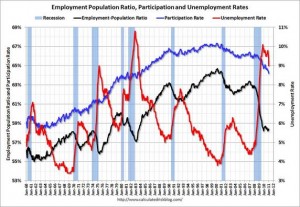Last Friday, the Bureau of Labor Statistics reported that the unemployment had fallen to 9.0%, a sizable drop from December’s 9.4% and November’s 9.8%. The BLS also released the payroll survey which indicated that the number of employed based on the non-farm payroll survey only increased by 36,000 in January. Such a small increase fails to keep up with trend labor force growth which averages about 125,000 per month (based on a civilian labor force of roughly 150 million that grows at about 1% per year.)
So is this good news or bad news? Actually, these two results are largely unrelated to one another. The unemployment rate is derived from a household survey which also revealed that the number of employed people rose by 117,000, that is almost the trend rate. The payroll survey tends to look at relatively older companies, which typically do not drive employment growth. James Hamilton, in a recent Econbrowser piece, lays out some of the relevant details. The chart below highlights key labor market patterns. The relatively low level of labor force participation puts downward pressure on the unemployment rate, which is why that indicator is not particularly informative with regard to the JOBS, JOBS, JOBS agenda. The details will entertain those of you who will take Econ 320 next term.
